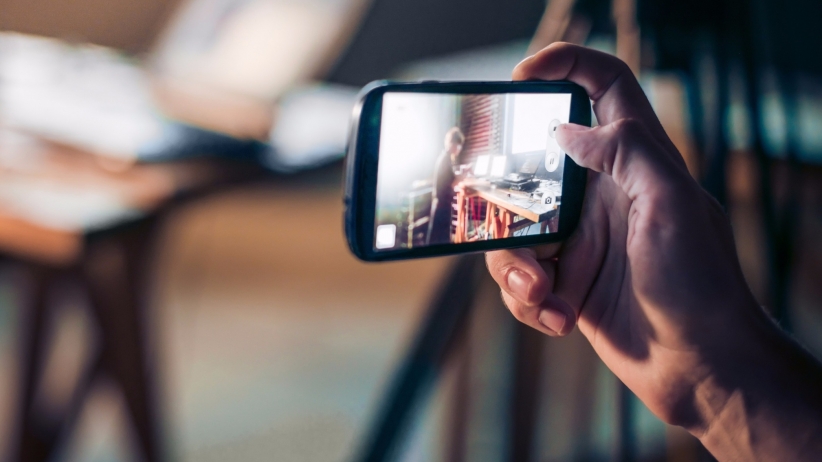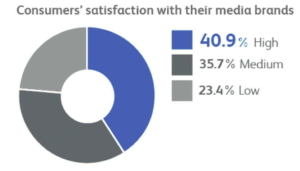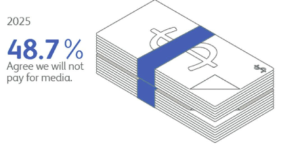Exclusives

M&E Journal: Will All Media Be Free by 2025?
Story Highlights
By Greg Schoenbaum, Global VP & GM Media & Entertainment Industry, Xerox Business Services
The media we consume gives us the vocabulary with which we translate the everyday. It is how we share modern folklore, from big stories of international events to more personal odes of emotion. Media comes with us everywhere. It helps us connect – and disconnect.
With smartphones and tablet devices becoming our constant companions, consumption of media services is exploding. Whether online, TV, radio, or social media, these services are becoming central to our everyday lives.
A recent three-part survey from Xerox titled The State of Customer Service 2015 explores consumers’ relationships and experiences with the brands behind the technology, communications, and media in their lives. Consumers across the U.S. and Europe let us into their lounges, bedrooms, commutes, and gym sessions. They told us about their sources of news, sports, social media, music, and TV and film. In total, 216 separate brands were named. In 2014, the top four brands alone represented collective revenue of $105 billion.
Channel preference and reality
Every day we are bombarded by communications and messages. And we all have different preferences for the way we would like to be contacted. The evolving customer omni-channel landscape shapes when, where, and how consumers prefer to get in touch. It’s time to contact each one on their terms.
Today’s 24/7 consumer expects support when it’s convenient, even if it’s in the middle of the night. But many media brands aren’t responding. Therein lies the chasm between consumer expectations and the reality of how customer service is being delivered.
Consumers are evenly split over their preference for digital or traditional communication channels. However, there are strong variations depending on country, age, and type of communication. Our survey found that one in four consumers overall prefer the call center when contacting brands, making it the most preferred channel. But new media users will turn to website selfhelp (20 percent) and email (18 percent) before contacting the call center (16 percent).
The survey’s findings show that consumers are demanding customer service via the channel of their choice, from brands that can show they understand them. The consumer may just have to pay more for it.
Satisfaction and loyalty
An accepted truth is that high customer satisfaction is the strongest indication of customer loyalty, as well as their intent to repurchase or leave. However, it is often accompanied by lesser truths: A customer will only ever get in touch if they are dissatisfied. The key to customer satisfaction used to be minimal brand interactions – but not anymore.
 In the media world, this prevents unnecessary contact, to seemingly effortlessly nurture customer satisfaction and protect future loyalty.
In the media world, this prevents unnecessary contact, to seemingly effortlessly nurture customer satisfaction and protect future loyalty.
Consumers are increasingly using their experiences in varying industries to rate the performance of media brands, and vice versa. In this newly demanding world, some media providers have found a way to impress.
When compared to highly satisfied customers in technology (47.5 percent) and telecommunications (33.8 percent), consumers’ satisfaction with media brands falls somewhere in the middle at 40.9 percent. Yet media brands should not rest on their laurels. An increasingly large segment (35.9 percent) also reported mixed levels of satisfaction.
U.S. consumers are most satisfied with their media providers (55 percent), while the French are most dissatisfied, with just over one in four reporting low levels of satisfaction. New media consumers are generally more enthusiastic about recommending media services, with a Net Promoter Score (NPS) of +28.5 compared to traditional media’s +14.8. The most loyal new media customers are those who pay a subscription, with only 6 percent likely to switch over the next 12 months.
Media brands’ highly satisfied customer base is proof that prevention is the best strategy. The fewer the interactions a consumer has with a brand, the more satisfied and loyal the customer base is. This follows the logic that if your customers are happy, you don’t hear from them.
Privacy and personalization
With the advent of smart automation and artificial intelligence, personalization is more scalable and deliverable than ever before. But in order to deliver the best relationship to a large customer base, you first need to make personal data work for you. There’s just one roadblock: your customers’ trust in your respect of their privacy.
As privacy and personalization emerge as a trade-off that shapes customer relationships, where do consumers stand on the subject? Every day, consumers and brands take part in a dance between discomfort and expectations over privacy. It is a negotiation of data for personalization, and of insight for customer experience.
In the media realm, this trade-off decides the level of functionality and recommendations consumers can enjoy. The more control they want on privacy, the less customized their experience.
 If a consumer forfeits her preferences, she can enjoy better recommendations; if she shares everything, her media may well be specifically curated for her. That said, 18.5 percent of consumers report being so uncomfortable with brands’ use of their personal data that they actively avoid sharing it, even if it is to improve the services they get for their money.
If a consumer forfeits her preferences, she can enjoy better recommendations; if she shares everything, her media may well be specifically curated for her. That said, 18.5 percent of consumers report being so uncomfortable with brands’ use of their personal data that they actively avoid sharing it, even if it is to improve the services they get for their money.
Millennials, at 28 percent, have the highest level of comfort in how companies use their data. In contrast, more than one in two over the age of 50 reported a discomfort with brands’ use of their personal data.
In a situation where almost half of consumers worry about brands’ use of their personal data, but only 25 percent see data transparency as an investment they’re willing to make, where does that leave media providers? Footing the bill.
Looking ahead
Consumers told us that they will expect more from their relationships with brands tomorrow than they do today. Understanding consumers’ views of the future gives us a window into the development of their expectations, and a head start on upcoming opportunities.
Consumers expect the technological leaps and bounds of the last decade to continue over the next one; reshaping the way they live, work, and communicate.
Today, 43 percent of consumers pay to access their favorite media outlets. Almost one in two consumers (48.7 percent) believe they will not pay for media services come 2025. Furthermore, society’s dependency on the channel through which most of today’s media is consumed, the Internet, is not set to waver in the next decade. In fact, 68.8 percent of consumers predict that access to the World Wide Web will ascend to become a basic human right.
In this constantly connected world, 56.9 percent of consumers believe they will have complete control over their personal data. French consumers are the most positive about the progress of the state of data privacy, with 70 percent of them believing they will have complete control over their personal data by 2025.
With this in mind, when information and media are increasingly free, what are consumers willing to pay for? Functionality. The willingness to pay for increased functionality is consistently over 70 percent across all age groups. In contrast, early access to innovation is only deemed a priority for 59 percent of Gen Z, and this figure falls with age.
These statistics highlight overwhelming customer frustration with technology and services – frustration that is stronger than a desire for the latest innovations. Within this frustration is an opportunity to do better.
Click here to translate this article
Click here to download the complete .PDF version of this article
Click here to download the entire Spring 2016 M&E Journal









